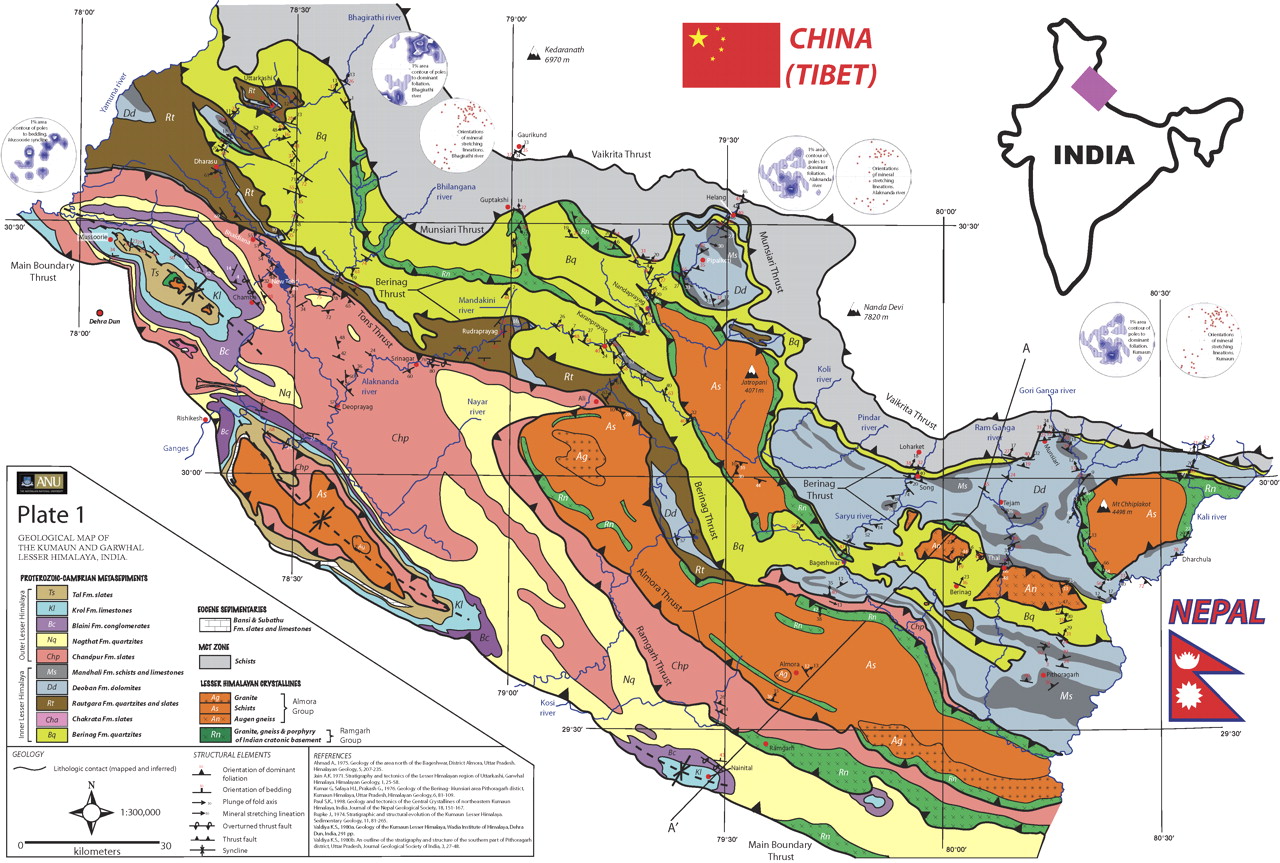Shiala Fm
Type Locality and Naming
Type section is in Shiala Pass, Niti area, Pithoragarh, Lasser Gad-Samgaon in Gori Valley. [Original Publication: Shah, S.K., Sinha, A.K., 1974. Stratigraphy and tectonics of the Tethyan zone in a part of western Kumaon Himalaya. Himalayan Geology 14, 1-27.]
Synonyms: Heim and Gansser, 1939 “Shiala Series” Shah and Shina, 1974 “ Shiala Formation”
[Figure 1: Location of the Kumaun-Garhwal region (from Celerier et al., GSA Bull 2009)]
[Figure 2: Geologic map of the Kumaun-Garhwal region (from Celerier et al., GSA Bull 2009)]
Lithology and Thickness
Claystone to Limestone. Comprises of shale, sandstone, shell limestone, quartz arenite, calcareous shale. 600-700m thick
Relationships and Distribution
Lower contact
Shiala Formation with the underlying Garbyang Fm is gradational. Boundary is marked at the base of crinoidal limestone of Shiala Fm.
Upper contact
Conformable contact with the Young Fm.
Regional extent
Kumaun to Garhwal regions
GeoJSON
Fossils
Several fossils groups such as brachiopods, bryozoans (Shah and Sinha, 1974; Goel et al., 1987a), conodonts (Goel et al., 1987b), acritarchs (Sinha et al., 1998), chitinozoans (Sinha et al., 2011), and melanosclerites (Sinha and Trampisch, 2013a,b) have been reported.
Brachiopods: Rafinesquina alternate zone (Rafinesquina, Leptaena, Favosites sp. etc) Monotrypa zone (Monotrypa sp. Strophomena sp. Chamaerops sp. Leptaena trachealis); Rafinesquina aranea zone (Rafinesquina aranea, R. muthensis) Orthis (Dalmanella ) testidunaria zone ( Triplecia sp. Skendium sp.) (Shah and Sinha, 1974; Sinha, 1989).
Nautiloids: Lambeoceras sp. Ormoceras sp.
Trilobite: Calymene nivalis
Trace fossils are Phycodes sp. Chondrite sp. Rusophycus; Planolites; Fucusopsis; Helminthopsis; Dimorphichnites (Shah and Sinha, 1974).
Chitinozoans: Belonechitina capitata, Belonechitina micracantha, Conochitina chydaea (Sinha et al., 2011; Sinha and Verniers, 2016).
Conodont: Amorphognotus tvaerensis (Goel et al. (1987a)
Melanosclerite: Melanoporella bulla, Melanosteus sp. (Sinha and Verniers, 2016).
Acritarchs: Local acritarch assemblage zones are proposed (Sinha et al., 1996, 1998). They are:
(IV) Leiofusa algerensis–Multiplicisphaeridium osgoodence;
(III) Tetradinium minutum–Dactylofusa sp. cf. D. oblancae;
(II) Domasia trispinosa–Deunffia monospinosa;
(I) Baltisphaeridium longispinosum var. longispinosum–Multiplicisphaeridium ornatum.
Age
Depositional setting
Shallow marine to offshore
Additional Information

